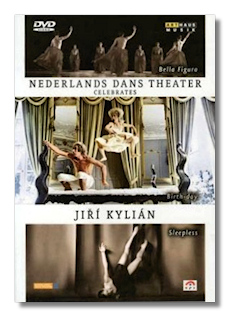
The Internet's Premier Classical Music Source
Related Links
- Latest Reviews
- More Reviews
-
By Composer
-
Collections
DVD & Blu-ray
Books
Concert Reviews
Articles/Interviews
Software
Audio
Search Amazon
Recommended Links
Site News
 DVD Review
DVD Review
Nederlands Dans Theater Celebrates Jiří Kylián

- Bella Figura
- Music by Giovanni Pergolesi, Antonio Vivaldi & Giuseppe Torelli
- Birth-day
- Music by Wolfgang Mozart
- Sleepless
- Music by Dirk Haubrich
Nederlands Dans Theater
Holland Symfonia/Henrik Schaefer
Arthaus Musik DVD 109099 128min LPCM Stereo Widescreen
Born in 1947, Prague-born choreographer Jiří Kylián has, for several decades, been one of the most distinctive figures in the world of modern dance. Originally a dancer himself, his unusual talent was recognized even before he was a teenager, and after he left Czechoslovakia (a departure which became permanent in 1968), he became a member of the Stuttgart Ballet. In 1973, he began his association with the Nederlands Dans Theater as a choreographer, and that association continues to the present time, although he stepped down as the company's artistic director around 2000.
The three dances presented here hint as to the wide range of Kylián's work, as well as to his philosophies toward life and art. At the same time, Kylián's distinctive style – acrobatic, abstract, always surprising – runs through all three works. The range of the Nederlands Dans Theater also is on display here. The films are beautifully photographed, and the sound is excellent too. Bella Figura is performed by NDT I, the main ensemble, composed of dancers between the ages of 23 and 42. Birth-day is performed by the NDT III, an ensemble in which all the dancers are 40 or older. Finally, Sleepless is performed by NDT II, whose dancers are 23 or younger.
Bella Figura can be translated as "putting on a good face" – in other words, what a performer must do when he or she is working, regardless of what he or she might be feeling at the time. To an often poignant Baroque score by Pergolesi, Marcello, Vivaldi, and Torelli (with two short neo-Baroque contributions by Lukas Foss added to the mix), the dancers respond to Kylián's question, "When does the performing act start? When we are born or when the curtain rises? Does it all end when we walk off the stage – or is there no end to the performance?" Tellingly, the final pas de deux continues in silence for a few minutes after Pergolesi's music stops.
Birth-day was inspired, in part, by Sabine Kupferberg, who is one of the performers, as well as Kylián's wife. The music is by Mozart, and the dancers wear period costumes and wigs. The premise is that this is Sabine's birthday, but for Kylián, there is a dark side to this: another birthday means another year closer to death. Birth-day, then, is unavoidably a piece about ageing and mortality, although it also is a very funny work, as it presents episodes with which any person, regardless of his or her age, can identify. The dancers perform in real time, sometimes in a kind of duet with a film of them in the background. The film also becomes the foreground in several episodes. A frantic Charlie Chaplin-ish effect was created by having the dancers perform to slowed-down versions of the music, and then returning the music (and the film) to a normal speed. There's an endearingly naughty bed scene for two of the dancers, and another in which two more dancers prepare a birthday cake and become rather abusive. Another episode, set to Mozart's Symphony #33, gives a whole new meaning to "fan dance." Birth-day is haunting, charming, and often laugh-out-loud funny, and so it is a great introduction to Kylián's work.
The last and shortest ballet (23 minutes – the other two are just under 40 minutes), Sleepless is dominated by a white, plastic curtain running at a diagonal across the stage. Vertical slits have been cut into the curtain, allowing the dancers to make unusual entrances and exits, and to, in effect, dissect their bodies. (Disembodied heads appear in unexpected places, strange hands appear out of nowhere to accept a dancer in front of the curtain, and so on.) There are three male-female couples, although the ballet begins and ends with a female dancer doing a pas de deux with her shadow, and there are important solo turns as well. The movements are harsher and more cutting than in the other two works. The music is harsher too; it is a sort of deconstruction of another work by Mozart, to the point where it sounds like music for a Buddhist ritual. Sleepless is a tense, enigmatic work, but it is softened by the physical beauty of the dancers themselves, and by the perfection of Kylián's constructions.
Each dance is accompanied by an approximately 12-minute interview with the choreographer, all recorded at the same session. Unlike in the dances themselves, the camera work here is not very good, and the interviewer is more eager than insightful (one can almost see Kylián rolling his eyes), but it is nice to hear Kylián talking to us about his work without explaining what it means. Indeed, his art is as intuitive as it is premeditated, and he admits that even he doesn't always understand what he is getting at until later on.
This was my first exposure to Kylián, and now I am a fan. Anyone interested in serious modern dance should check him out. This is beautiful, exciting stuff.
Copyright © 2008, Raymond Tuttle





















